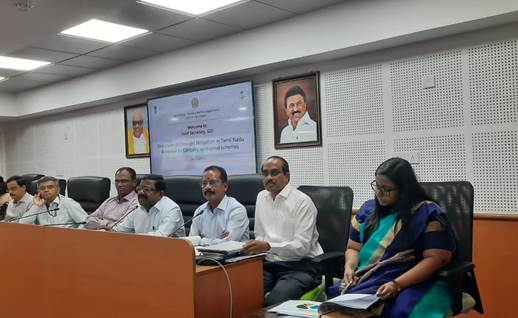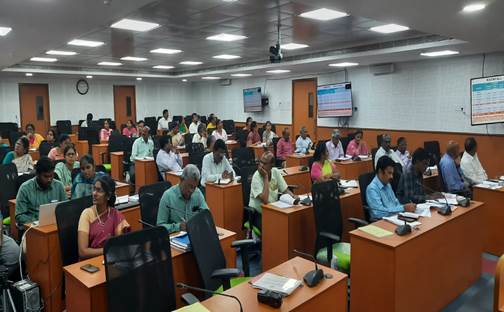
Chennai: With 10 districts facing deficient South West monsoon and unseasonal rainfall happening in the State affecting the harvests of crops, the Central and State governments have swung into action to mitigate drought in Tamil Nadu.
It is informed that the Agricultural Production Commissioner (APC) and Secretary to Government, Agriculture Farmers’ Welfare Department, Tamil Nadu in Chennai already held two preliminary meetings for drafting the drought mitigation plan and accordingly, 23 sensitive districts vulnerable to drought have been identified with 116 blocks.
While the Director of Tamil Nadu Disaster Risk Reduction Agency, Raman, remarked that it is too early to predict drought, the State is closely watching the status of indicators as per the ‘Manual for Drought Management’. Drought monitoring cells have been formed at state and district levels here.

A special meeting was held today under the co-chairpersonship of Ashish Kumar Srivastava, Joint Secretary, Union Ministry of Agriculture and Farmers Welfare, and C. Samayamoorthy, Agricultural Production Commissioner (APC) and Secretary to Government, Agriculture Farmers’ Welfare Department, Tamil Nadu in Chennai to review the status of drought preparedness of the state and implementation of all centrally sponsored schemes.
Making a detailed presentation on steps taken by the state government to mitigate drought and the status of preparation of the contingency plan, Dr L. Subramanian, Commissioner of Agriculture informed about the rainfall distribution, water storage in all reservoirs, and crop coverage.
APC Samayamoorthy also informed about the emphasis being given to over-exploited and critical firkas for the installation of a Micro Irrigation system to improve the ground water status. Agro-Forestry is given focus under the Green Tamil Nadu Mission wherein forest tree seedlings are given free of cost.
The adoption of various strategies was discussed in detail during the meeting. These strategies were the cultivation of less water-intensive crops, positioning of seeds and fertilizers, integration of rainfall data collected from 608 standard rain gauges and 257 Automatic Weather Stations established by different agencies, adoption of drought management cultivation practices like community nurseries and direct seeding, construction of water harvesting structures to store rainwater, the establishment of cattle shelters and availability of green fodder and dry fodder.
Joint Secretary Srivastava remarked that the Government of India was very keen to know the status of the state’s preparedness for drought situations if monsoon fails and coordination among different agencies. Further, he instructed putting in place a specific monitoring mechanism, particularly in sensitive districts. He advised that all centrally sponsored schemes should be implemented in time for the welfare of farmers for which the release of funds should not be a problem. In this regard, the APC and Secretary, Government of Tamil Nadu informed that expeditious steps have been taken by the State Government to complete the physical activities and to utilise the funds by adopting all the stipulated norms.
The Joint Secretary appreciated Tamil Nadu for being first in the country in the preparation of the consolidated Annual Action Plan well in advance and getting the funds released for the year 2023-24 and also launching a new portal called Tamil Mann Valam for the welfare of the farming community. He remarked that it will act as a model to the entire country. Finally, he cautioned the State officials to be on their toes to tackle the drought situation if it arises and also to implement centrally sponsored schemes at the earliest.
Meanwhile, the rainfall deficit in Maharashtra stood at 39% as of date. However, during the month of July, the monsoon is expected to pick up in the state as per India Meteorological Department. While the Konkan region has received above-normal rainfall, it has been deficient in other regions namely Marathwada, Vidharbha and Madhya Maharashtra. However, considering the fact that over the next two weeks, rainfall is likely to be either normal or above normal, the outlook is quite optimistic.
As on July 3, 2023, 20.60 lakh hectares of area has been sown in Maharashtra and is expected to further pick up over the next few days. Soybean and Cotton are major kharif crops in the state followed by pulses and paddy.
As far as the implementation of central schemes is concerned, Maharashtra state has performed well in implementing the ‘Per Drop More Crop’ scheme. In the year 2022-23, under this scheme subsidy has been distributed to 1,27,627 beneficiary farmers and an area of 1,12,000 hectares of land has been brought under irrigation.
– global bihari bureau





